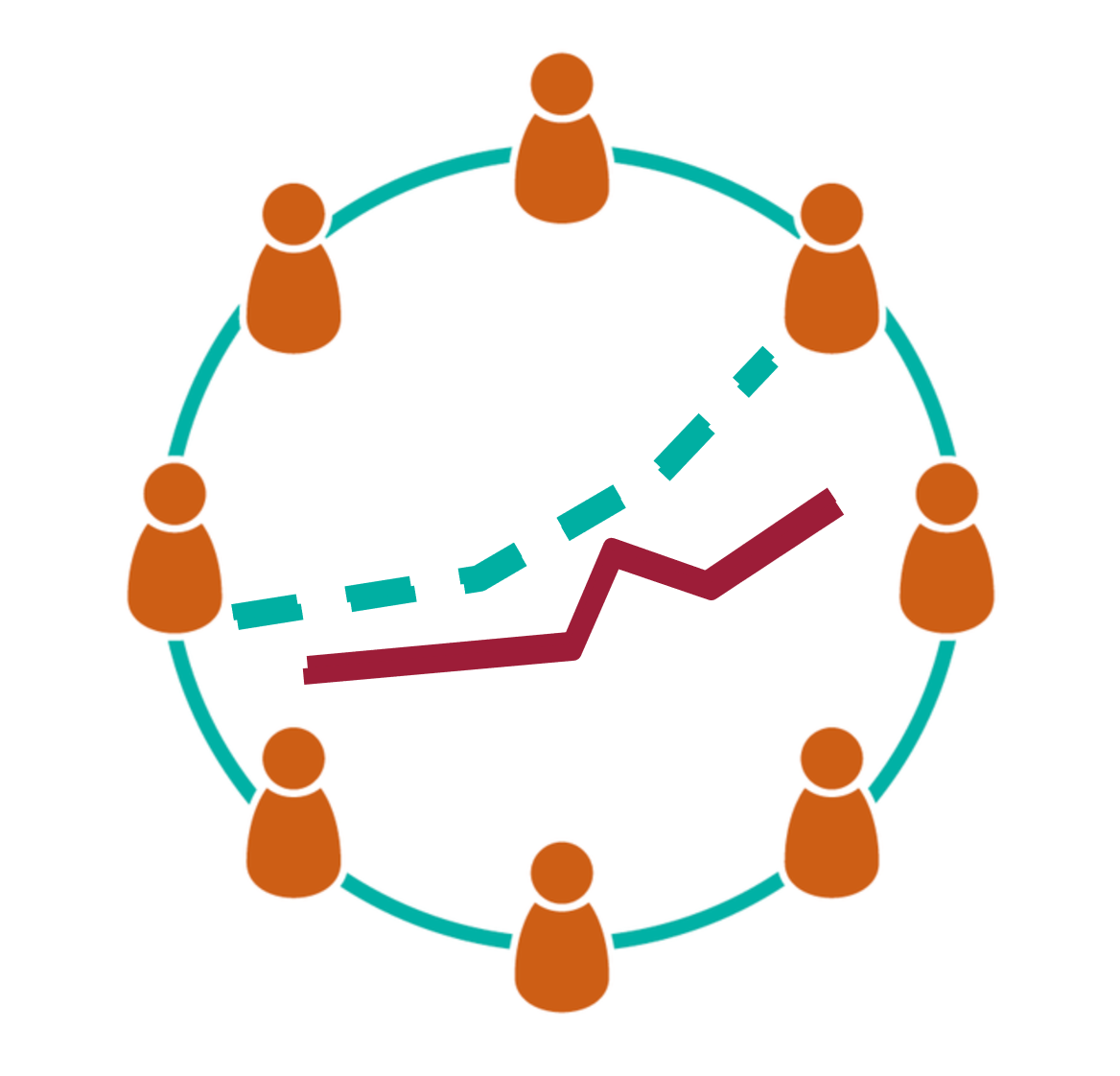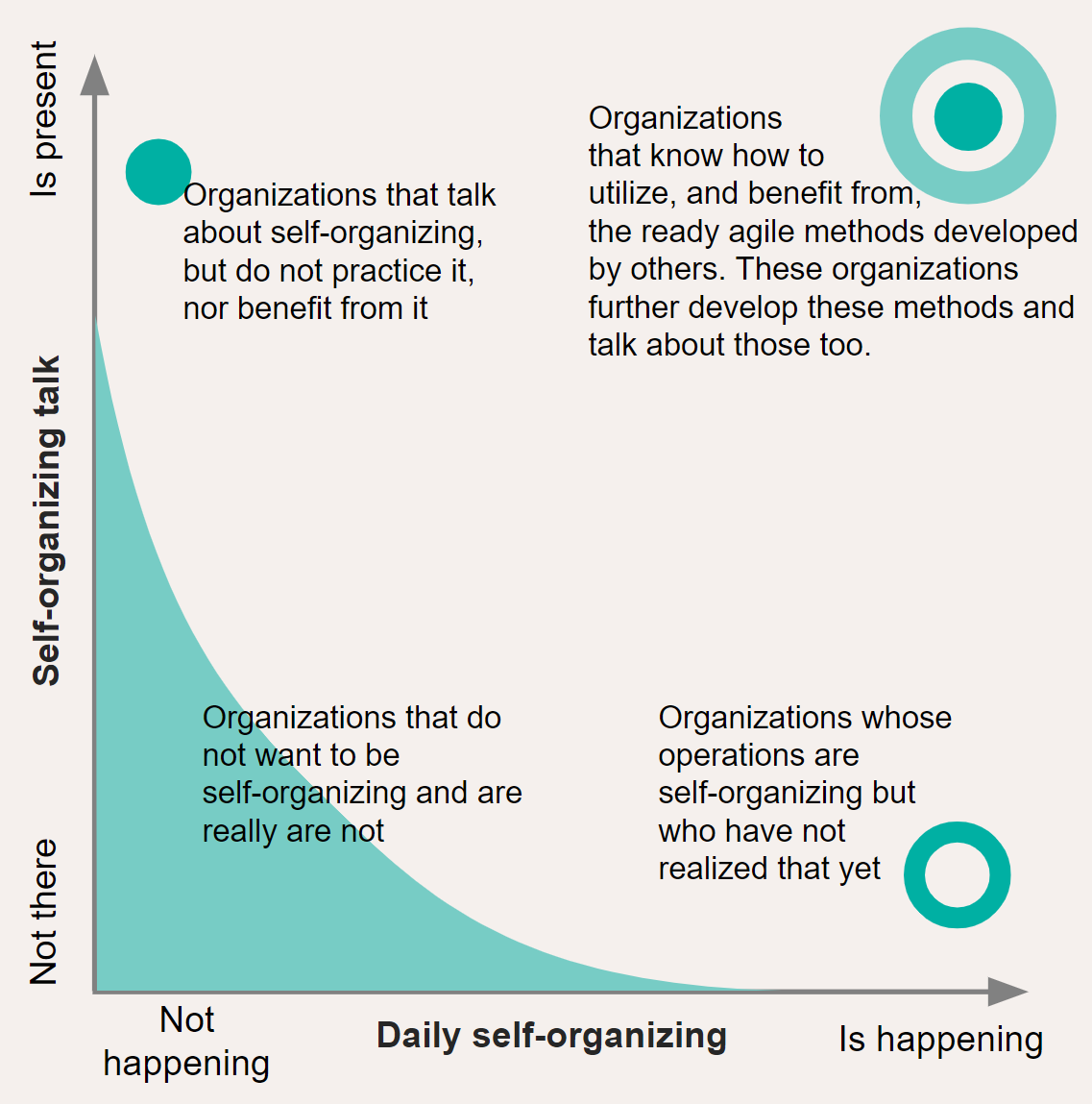Results oriented self-organizing - happy customers and employees
In order to be success the results oriented self-organizing requires organization to have tight customer focus, solid strategy along with fluency on measurement and data usage. This, according to Withmore’s Lean-consultant and long time self-organizing practioner Miika Kuha and Petri Aukia, IT-management professional and strategy consultant, will bring benefits like continuously improving organizational culture, job applications from the sharpest skills on the domain and organic growth via satisfied customers.
Many myths are associated whit self-organizing and especially in it-field, the term has been used to lure in talent. Promise has been greater freedom and possibility to influence. Instead of self-centered gains the self-organizing actually focuses on commonly agreed rules and practices. These way of working conventions are agreed and decided to take the organization towards common goals and targets.
“Instead of thinking the self-organizing as an revolution, as it might be depicted by some guru, it is more about how different individuals work together in an clever way“, Petri Aukia summarizes
How to self-organize for achieving targets?
“In order to work self-organizing needs a common target. It can be a big goal that is devided into smaller targets a cross the organization. Also data is needed – mere targets are nothing, if there is lack of visibility on how the organization is progressing. Appropriate measured data, accountability to make the decisions and take actions for achievingn the targets”, Kuha states.
Self-organizing is really more co-organizing, where whole of the organization is aligned to work for common goals and metrics. Instrumets provided are power and freedom, so that each employee can work in a best possible way to achieve the targets.
“Good strategy is often based on reaching for such wins that are not obvious but challenging and require effort. Good self-organizing can be observed when improvement initiatives are explicitely focused on gaining strategic wins“, Aukia describes how self-organizing intertwines with common and concrete goal.
“As I see it, there are two approaches to self-organizing. One can emphasis a big cultural change and use that to flush in the open the ones opposing the change. This way dialogue about the fears and boubts of the selected direction can be started”, Petri Aukia ponders.
What the self-organizing requires from the organization?
Clear targets and strategy
Data-centricity and ability to measure results in fast intervals
Enough power and freedom
Growth of profitability via customer satisfaction
” As organization wide scale cultural change is not usually an option, with Miika we have seen more rationale the approach, where self-organizing is increased gradually. Self-organizing patterns are incorporated to organizations’ operations in phases. This will ensure the organizational culture improvements. No one needs to fight back as the changes are reasonable, safe, and quite down to earth”, he continues.
Is your organization actually self-organizing?
Organizations can be categorized roughly in four based on how self-organizing they want to be, and how much they practice self-organizing patterns and practices.
“Self-organizing works well on those organizations where strategy is to be customer centric and to deliver good products and services. Be market leaders and profitable because of the job well done. On the other hand, for the organizations, where aim is to be profitable via some other means, the self-organizing does not necessary fit”, Aukia describes.
“Self-organizing excels especially on those contexts where there is no time to circulate the questions, related to customers’ needs, with the management. Everyone, who works at the customer proximity, should be able to do fast decisions at the spot per changing needs”, Miika Kuha stipulates.
Those organizations that do not have that do not have systematic way to train and learn self-organizing, including the management, often have mixed hybrid as a way of working. Traditional organizations often have the old hierarchical models going strong, where as modern startups have very strong self-organizing by nature, without any strategy paper stating this should be the case.
“Work in Finnish organizations is done with a big heart. Clear indicator for the need for change is, if you hear statements like: “we do not do that, even the management thinks we do”. Probably the attending the customers needs are, in these cases, prioritized over the management guidance. People have taken responsibility of their own work, against the orders given to them, to serve the customer better”, says Aukia.
See also (in Finnish): Agile management - organization’s checklist (Ketterä johtaminen – organisaation tarkistuslista)
Self-organizing improves the risk management and invites best talent to the organization
Most organizations have to compete for the top talent. Recruitment professionals and management alike think how to solve the increasing talent shortage. Especially in the technology domain the overheated workplace market means that only those whose employee image is most appealing even get the applications for the open places.
”Research tells that most of the Finnish subject matter experts choose their workplace based on the organizational culture. If organization does not develop their culture, they find themselves in an situation where top talent is hired by the organizations with the top culture and only average talent is even available for these laggard organizations. The awkward part is that this poison effects slowly but surely. Year after year the laggard organization becomes less competitive”, Aukia paints the future in an organization who remains stationary.
”The situation can be patched by purchasing of the talent, with money you can buy consultants. But then you can again ask where that path leads. For how long the organization is even capable of making those purchase decisions, if organization’s own talent pool gets ever narrower and no new replenishment comes in”, Kuha asks
“Self-organizing builds cohesion into the organizational culture. I do not mean tribe culture, but the core of self-organizing. When the youngest person in a meeting can bring such information on the table that changes the whole direction of the meeting. If organization has this as a typical part of the culture, we are already a long way into the self-organizing “, Aukia illustrates
What good the self-organizing brings?
Self-organizing aligns the organization behind the common targets
Self-organizing builds and enforces co-created organizational culture, that in turn attracts the best talent
Self-organizing gives employees power to act in best possible way within customer interactions, which leads to improved customer satisfaction
Self-organizing improves the risk management – anyone can bring data for the decision making, risks are seen faster, and they can be mitigated more easily
Self-organizing produces organic growth
”I would like to highlight also one key benefit, self-organizing comes with awesome risk management feature. When people can bring up their observations of the changing markets, that are potentially going to impact the organization, the organizations probability to drift into market situation that it realizes too late and only after competitors, gets significantly slimmer”, Aukia adds.
Read also (in Finnish): Self-organizing organization succeeds, when it is supported by minimum structures(Itseohjautuva organisaatio onnistuu, kun sille tarjotaan minimirakenteet)
Data ensures that the direction of the self-organizing is rational
”Self-organizing comes with a paradox, a line of thought that the self-organizing is somehow fluffy and the hierarchical management is more analytic and rational. Nothing could be further from the reality, for the self-organizing works on those organizations that are ready to measure themselves”, Aukia analyzes
Paramount in self-organizing is being data-driven – when decisions are made together and power is distributed wider, the validation – sensibility and profitability of the decision is backed up by data and metrics.
”Petri talks about the youngest person in a room, whose point in a meeting changes the decision. If there is a lack of cultural backing up opinions with the data, it is really hard to justify decisions without appropriate seniority. On the other hand, if the decision-making model in a company is data-driven, even young persons can bring points that change decisions and the direction of the company. Data-driven approach is extremely important”, Kuha emphasizes.
“Those organizations that cannot tolerate measuring themselves, should not take the self organizing path. If this is the case one should contemplate why we are afraid to be measured, and what is the scary part. In the shared decision making, where decision does not come based on seniority, there needs to be deal breakers – data is such. Without data self-organizing will not work at all.”, Aukia replies.
As the measurement is not happening only annually and results are followed regularly, decision making cycles are significantly faster in organizations having self-organizing capability than in traditional organization.
“Keep the working periods short and evaluate them for example every three months. This enables continuous evaluation of e.g. if selected person is suitability for the role or if the selected strategy giving us better results”, Kuha describes
“Integral part of the self-organizing are the pilots or experiments. When larger group is given right to make decisions, to avoid running out of organization’s resources, most of the decisions must be really affordable. Utilizing the experimentation expensive decisions can now be made cheaper”, Aukia continues.
When drivers are described, the organization gets to harness everyone’s eyes and brains for thinking what is the best way to focus common energy. At the same time the probability to align the organization’s and individuals’ goals. A common path for the organization and individuals’ gets created.
“At times there are situations, where there is not enough data, but anyway we should proceed. Then we should ask: Is this good enough for now and safe enough to try. Perceived safety can be added by shortening the trial period people agree. Then the decision is made. Consent based decision making ensures that we always move a bit forward, collect more data and can take yet another step”, Miika adds
We are already self-organizing, why we should be more of it?
Like said, many organizations, especially in startups, the culture is by nature very self-organizing. And data is utilized in many occasions, notably in sales and marketing. Why then the self-organizing should be codified and documented?
“One thing to consider is that the self-organizing works in the context that is prevailing at that particular moment. As long as nothing changes. But in practice everything is changing all the time. Therefore you’ll need to have some mechanism of continuous adjustment – improvement in place. Somehow, we need to understand where we want to get with our way of working. If the current way of working is not documented or described, it is crazy hard to think together how it could be done better in the future”, Miika points out
“Organizations change more than the people within even notice. New graduates join, people change organizations or get promoted. Poorly documented self-organizing has couple of consequences – if way of working is unclear, role changes, increased responsibilities and other changes start to feel heavy. Another angle is that some of the people have not explicitly selected the self-organizing way of working. The clearer the agreed way of working is described, the more it helps new people to learn and fit in”, Aukia adds.
See also (in Finnish): Way of working transformation service (Toimintatavan transformaatio-palveluun)
Do you see need for self-organizing in your organization? Would you like to discuss the opportunities self-organizing would enable in your organization? Please contact us!
Also connect with us via the Linkedin:




